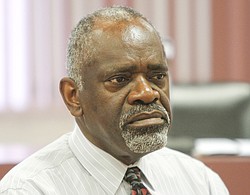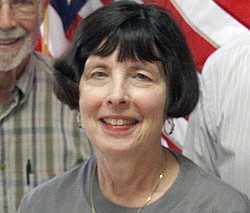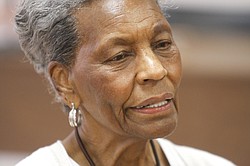The Dream 50 years on
RELATED: • Valley residents recall life in segregated South
• Compiling a local legacy: Blacks in history
By PETER H. MILLIKEN
milliken@vindy.com
YOUNGSTOWN
Connie Hathorn on Civil Rights

Youngstown schools Supt. Connie Hathorn recalls his childhood in Mississippi before the Civil Rights Act of 1964.
Penny Wells on Civil Rights Act

Penny Wells, director of Mahoning Valley Sojourn to the Past, talks about the Sojourn trips with local high school students to civil rights movement landmarks.
June Ewing on Civil Rights

June Ewing of Youngstown, retired OSU nutrition program agent in Canfield, talks about her upbringing in Charlottesville, Va., during segregation.
The landmark Civil Rights Act of 1964 opened many doors for African Americans, but 50 years after its passage, blacks and whites are still separated by residential patterns; many black middle class professionals have moved to the suburbs and there’s insufficient inter-racial dialogue, according to local social justice advocates.
“It abolished segregation in public facilities. The law at least said restrooms had to be integrated, movie theaters had to be integrated; restaurants, motels, libraries and public accommodations had to be integrated,” observed Penny Wells, of Boardman, director of Mahoning Valley Sojourn to the Past and a retired Youngstown City Schools teacher.
Sojourn promotes recognition of early events and leaders in the civil rights movement by taking city schools students on trips to civil rights movement landmarks and challenging them to decide how they will make a difference in advocacy for social justice.
Locally, the 50th anniversary of the signing of the act will be observed in a public commemoration and conversation titled “50 Years Later: Remembering What Is Civil and Doing What Is Right,” from 6 to 8 p.m. Tuesday at the Youngstown Historical Center of Industry and Labor, 151 W. Wood St.
The free program, sponsored by the Martin Luther King Jr. Planning Committee of the Mahoning Valley, will include a presentation by Al Bright, an artist and retired Youngstown State University professor.
Then-President John F. Kennedy called for enactment of the law in a June 11, 1963, speech, 5 1/2 months before he was assassinated on Nov. 22, 1963.
Passage of the law was a major goal of the Aug. 28, 1963, March on Washington, during which the Rev. Martin Luther King Jr. gave his “I have a dream” speech.
The bill passed the U.S. House of Representatives, 290-130, on Feb. 10, 1964, and the U.S. Senate 73-27, on June 19, with the House agreeing to a Senate amendment, 289-126, and President Lyndon B. Johnson signing it on July 2.
“Johnson knew how to work both sides of the aisle and get Republicans and Democrats to support that,” Wells observed.
Besides barring discrimination in public accommodations, the law banned discrimination in voter registration, barred discrimination by government entities receiving federal monies, and barred employers of 15 or more people from discriminating on the basis of race, religion, sex or national origin.
“It made us aware of the voting rights and about equal pay,” said June Ewing of Youngstown, a retired Ohio State University nutrition program agent in Canfield, who experienced segregation while growing up in Charlottesville, Va.
“That gave us a chance to have a voice in the government, and that’s why it’s so important that people get to the polls and vote,” said Connie Hathorn, Youngstown schools superintendent, who grew up under segregation in Mississippi.
“It’s generally true that African Americans have access to public accommodations, even in Mississippi and Alabama today,” observed Staughton Lynd of Niles, a retired Northeast Ohio Legal Services lawyer.
“There are more local black public officials in Mississippi, proportionately to the population, than anywhere else in the country,” said Lynd, who coordinated Freedom Schools in 1964.
Those summer high schools throughout Mississippi were designed to provide educational enrichment to black students that went beyond the limited learning experiences available in segregated public schools.
“It legally opened the door for people,” including black people and women, the Rev. James Ray of Poland, a retired Youngstown State University campus minister, said of the 1964 act.
The Rev. Mr. Ray attended the 1963 March on Washington and was among clergy who served as peacemakers at subsequent civil rights movement events in the South.
Wells said the Voting Rights Act of 1965 was even more significant than the 1964 act because it outlawed literacy tests and other barriers to voter registration and allowed the federal government to pursue enforcement actions against non-compliant communities or states.
Lifting barriers to voting meant more members of minority groups could participate in elections to decide who would hold judgeships and become sheriff and occupy other public policy leadership positions, Wells explained.
Hathorn said voter participation and the realization that every vote makes a difference is the key to fulfilling the goals of the civil rights laws.
“If you have 300,000 or 400,000 people saying that ‘my vote won’t make a difference,’ that’s 300,000 to 400,000 votes you’re not going to get,” Hathorn said.
“And then they start criticizing how the country is, or how our community is, or how politics is because they won’t vote,” Hathorn added.
“We have to keep fighting and keep alert as to all the laws and all the underhanded things that can be done to try to keep us from voting,” Ewing said.
She said vigilance is necessary concerning voter identification laws, restrictions concerning days and hours of early voting, bans on the use of church buses to take voters to the polls, and ward and precinct boundary changes that could “weaken the black vote.”
“Schools are very segregated today, unfortunately, because of demographics, where people live, white people moving to the suburbs and a lot of private schools,” Wells observed.
“What has happened, and it’s such a cruel irony, is that middle class professional African Americans have been able to move out,” also to the suburbs, thereby depriving inner city black youth of role models living in their communities, Lynd added.
Lynd and Mr. Ray also lamented today’s lack of dialogue between black and white people.
“When are blacks and whites in the Mahoning Valley going to get together again in the way that we worked together that summer” of 1964, Lynd asked.
A year after his 1983 arrival at YSU, Mr. Ray noted that he helped launch an inter-racial dialogue, which evolved into a coalition for diversity.
“There’s a strong need for there to be more intentional efforts of black and white folk together to address things” of mutual concern, Mr. Ray said.
However, Ewing said it’s important that parties to such discussions not approach them with an air of superiority.
“Black people resent someone trying to feel that they are superior,” she said.
With civil rights laws, “We have the legal means to say ‘that’s right’ or ‘that’s wrong’ — the legal means to back up the way life should be lived, but there’s a lot of stuff that’s still going on,” Mr. Ray said.
He was referring to poverty, broken homes, and the financial lure of the drug culture, all of which can impede the academic progress of urban black students.
“That’s not only a terrible drain on the black folk who live in the inner city, but it’s a drain on all of us,” Mr. Ray said.
“Life for God’s people here and in many places in this country is not what it ought to be,” he concluded.
 43
43
